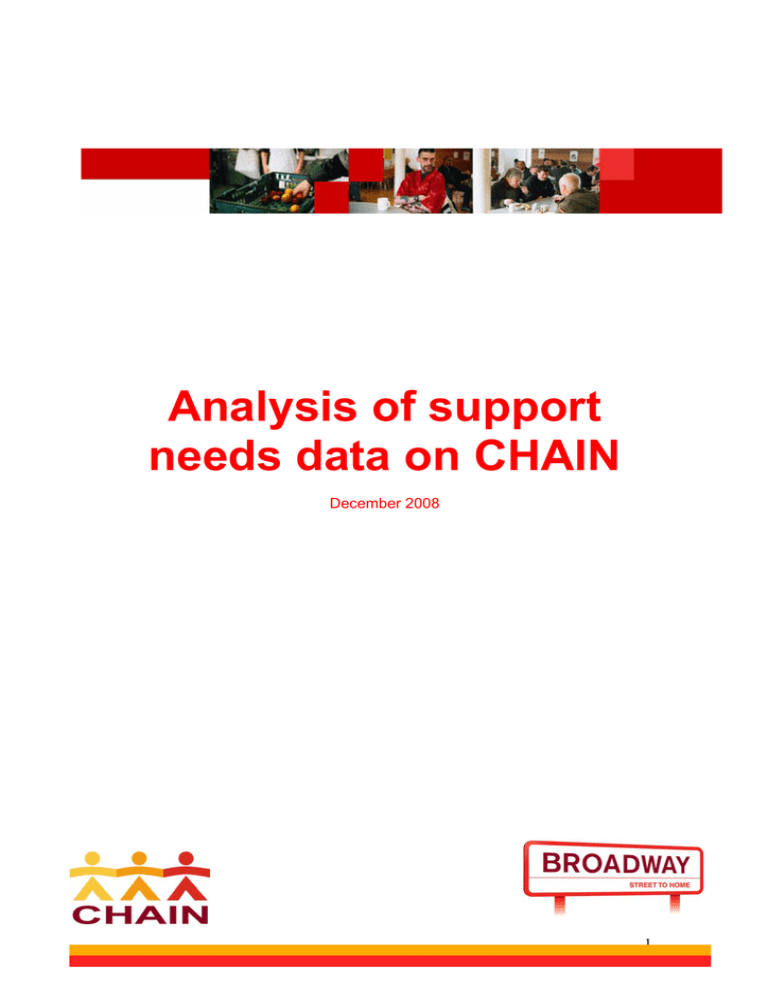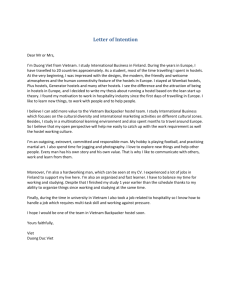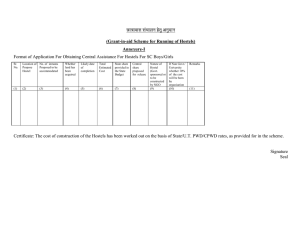Analysis of support needs data on CHAIN
advertisement

Analysis of support needs data on CHAIN December 2008 1 Analysis of support needs data on CHAIN 1 Background CHAIN provides assessments by outreach workers of clients’ support needs around substance misuse, physical health, mental health - forms can be updated as frequently as required. The information is used in reporting from the CHAIN system and is being used in the National Centre for Social Research/ Broadway CHAIN research project. Given the importance of this information, in November – December 2008 the CHAIN team undertook a project to assess the use of support needs data fields and accuracy of the data on CHAIN. This report presents the findings of • Analysis about how soon after first contact and how regularly support needs forms are completed was undertaken. (Section3) An exercise to compare forms from CHAIN completed by outreach workers with assessments made by hostels. Hostels are often able to make a more detailed assessment of needs using various tools and measures such as the ‘outcomes star’. (Section 4) 2 Conclusions Support needs forms are currently updated around once every four months. The period between reviews has reduced in recent years. (Section 3) There is an 80% or higher match in the prevalence of drug and alcohol support needs reported for individuals by hostels and by outreach. The match rate is understandably lower for mental and physical health. (Section 4.2) Figures reported from CHAIN are more likely to underestimate than overestimate the prevalence of support needs in the single homeless population. Broadway and others using CHAIN data can be more confident about how accurate support needs information from CHAIN is. The debate about this data is evidence based – prior to undertaking this work all CHAIN could assert was that the data was the best top line data available about rough sleepers support needs given the wide use of the system. Given that in the areas of drugs and alcohol the match between CHAIN and hostel data is high we may be able to get more value from the information held. For example by extrapolating data collected during this exercise to assess the likely profile of severity of support needs amongst outreach clients. (Section 4.4). It would be possible to undertake follow up work exploring the reason for mismatches – for example speaking with outreach teams and hostels about case studies where information does not match. This will provide an indication of whether the mismatches reflect fluctuation in needs or whether new tools for outreach teams to assess mental and physical health needs in particular could be useful. 2 3 Findings – use of support needs forms The base for the CHAIN data used in the analysis in section 3 is data for all CHAIN clients with 2 or more actions (15,526) and all forms completed for these clients (12,810). Inevitably a proportion of client records had to be excluded from analysis for example where there had been issues with the merging of duplicate records. Timing and Frequency of assessment On average, forms are reviewed just under once a year (every 327 days). However, this time between forms has been decreasing in recent years. The average for clients whose records were created after 2006 is 165 days elapsing between assessments and from 2007 this decreases to every 121 days – so just less than four months between forms on average. Figure (a) Average days between forms being completed When client record was created All Clients Clients created 2006 Clients created 2007 Clients created 01/01 - 30/06/2008 Average days between assessments 327 254 157 85 The average number of days between the creation of the client record and the first form is 165. But it is important to note that approximately 50% of first forms are done on the day a the client record was created — if these are excluded the average rises to 342 days for all clients and 124 days for clients created from June 2006 forward. Figure (b) Average days between a client record being created and a needs assessment being recorded on CHAIN All clients Average days from client record being created and first needs assessment being recorded % of support needs assessments completed on day record created 165 52% Average days to first form excluding those completed on day record created 342 Clients created June 2006 forward Average days from client record being created and first needs assessment being recorded % of support needs assessments completed on day record created 22 Average days to first form excluding those completed on day record created 49% 124 3 In order to determine how recent form information is, the date of the last form was compared to the date of the last action on CHAIN. The average time between the last support needs form being completed and the last action was 204 – around 6.5 months. This reduces to 143 days from 2006 forward. In some cases the date of the last form was after the date of the last action. This may result from faulty merging of duplicate clients, or it may indicate that a client’s needs are in some cases being reviewed in a period of inactivity. Unfortunately, we cannot determine how many cases fall into which category Figure (c) Average days between last form and last action All clients Average days from last form to last action % forms later than last action Clients created June 2006 forward Average days from last form to last action % forms later than last action 204 14% 143 8% In all case above, the timing and frequency of form use improves greatly for clients created more recently. 4 4 Findings - comparing outreach support needs assessments with hostel assessments 4.1 Methods To compare outreach workers top line assessments of support needs recorded on CHAIN with detailed assessments made by hostel staff 23 hostels were selected to cover all boroughs and the range of hostel size. Current client lists were sent to hostels on an Excel form which enabled them to rate support needs for alcohol, drugs, mental health and physical health as high, medium, low, none, or not known. 16 hostels replied, giving data on 227 clients. 32 clients had to be eliminated as they had no form on CHAIN, leaving a sample size of 195. These replies were compared to the most recent form data on CHAIN. In each of the 4 categories, responses including ‘unknown’ or ‘not selected’ were excluded. The hostel ratings of high, medium and low were converted to ‘yes’ or ‘no’ to facilitate comparison with CHAIN data, but were retained for the level of support needs analysis. 4.2 Overall match rate The overall match rate when comparing support needs for individuals from CHAIN and from Hostels are shown in figure (d). A match is where: o A hostel stated the client has a high, medium or low support need in a given area and CHAIN states ‘yes’ against the same support need o A hostel states that the client has no support need and the CHAIN record also states ‘no’. In some cases as mismatch will occur as a new support need has developed over time or a support need has been fully addressed over time – for example where someone uses alcohol to help them cope with elements of rough sleeping such as the cold and then reduces or abstains once they are in a hostel. However support needs are often of an enduring nature albeit with frequent variations in severity of need. We therefore suggest that most mismatches would occur where an outreach team has not been able to make the full and detailed assessment that would be made by a hostel. The match rates for drugs and alcohol are very high (84% and 80% respectively). (see section 4.3 for more information about the mismatches). Match rates for physical health and mental health are less high. This could be for the following reasons: o Assessments of mental health are subjective and complex - outreach workers maybe hesitant to label a client as mentally ill without very firm foundation o Physical health problems are sometimes temporary or not mentioned by the client while other matters are more pressing. 5 Figure (d) % of 195 clients where forms on CHAIN matched assessment by hostels by four support needs areas 84% Drugs 80% % match Alcohol Mental Health 65% Physical Health 53% 0% Drugs Alcohol Mental Health Physical Health 4.3 20% 40% 60% 80% 100% 84% 80% 65% 53% Mismatches – do outreach teams record higher or lower prevalence of support needs? As shown in figure (e) where the assessments do not match, it is much more common for the outreach team to have rated the client as ‘none’ and the hostel to have identified a need rather than the other way around. So figures reported from CHAIN are more likely to underestimate than overestimate the prevalence of support needs in the single homeless population. Figure (e) Mismatches - % of occasions where hostel and outreach assessments do not match Alcohol Drugs Mental Health Physical Health 4.4 Outreach reports need but hostel do not 5% 2% 3% 14% Hostel reports need but outreach do not 15% 14% 32% 33% The level of support need for clients included in analysis CHAIN provides a top line yes/no classification for support needs. Hostels use various tools to rate the severity of support needs and through this track clients’ 6 progression. Various inventories, scales and indicators are used for this purpose. We asked hostels to simply rate each support need identified as high, medium or low. The results give a rough and ready indication of the prevalence of different levels of need across the support needs. In the case of alcohol and drugs, amongst those that have a support need the split between high medium and low is fairly even – around a third in each group. In the case of mental and physical health lower levels of need are more prevalent than high levels of need. 4.5 Level of Support Needs as reported by Hostels Alcohol Drugs High Med Low None Not known Mental health Physical health 21% 21% 11% 18% 22% 19% 19% 17% 24% 20% 34% 31% 28% 37% 33% 31% 2% 2% 2% 2% 7


